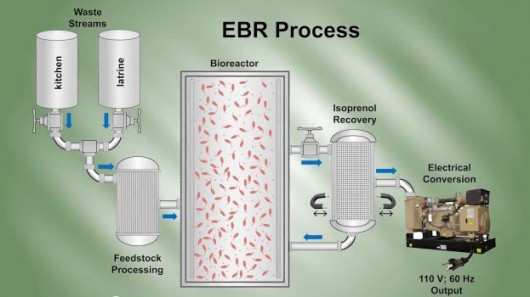Mobile machine can make biofuel for military and humanitarian operations
August 20, 2012

A diagram of the process utilized by the Endurance Bioenergy Reactor
Researchers at the U.S. Department of Energy's Argonne National Laboratory (ANL) have created a device called the Endurance Bioenergy Reactor (EBR) that can produce bioenergy on location, using waste from kitchens and latrines. The fuel can go directly into engines and generators without any need for refining, avoiding the complications of distribution and supply chains associated with fuel production. The researchers say the EBR can produce 25 to 50 gallons (94.6 to 189.2 liters) of biofuel a day from waste streams or processed cellulosic materials.
The EBR is based on an engineered photosynthetic bacterium, an organism that divides itself quickly. The technology combines plant enzymes with an efficient light-harvesting system that is found in abundance within these cells. The reactions from the combination of enzymes and bacteria result in fuel molecules that are foreign to the bacterium, which then expels them into a culture medium where they can be sequestered and separated from the fermentation broth. When it gets to that stage, the molecules can be used, without refining, as diesel surrogates in engines or generators.
Because of its inherent mobility, the system would be ideal for military settings, humanitarian activities in emergency zones, native peoples' villages, and in any other remote setting. The same version of the system can be used for military and civilian purposes. It is estimated that one EBR can fuel a generator that can charge up to 60 light- to medium-duty electric vehicles per day, with an estimated daily range of 50 miles (80.4 km).
The EBR is past its development phase, so all the team needs to do now is to deal with integration and scale-up issues. The researchers anticipate only a small investment will be necessary, somewhere between US$2 and $3 million.
The Argonne National Laboratory is part of the US Department of Energy. Itís a multidisplinary project that works on pressing national issues related to science and technology.
In the video below Argonne bioscientist Phil Laible talks about the EBR and its applications.
Source: ANL
 Brazilian-Italian Antonio Pasolini graduated in
journalism in Brazil before heading out to London for an MA
in film and television studies. He fell in love with the
city and spent 13 years there as a film reviewer before
settling back in Brazil. Antonio's passion for green issues
- and the outdoors - eventually got the best of him and
since 2007 he's been writing about alternative energy,
sustainability and new technology.
Brazilian-Italian Antonio Pasolini graduated in
journalism in Brazil before heading out to London for an MA
in film and television studies. He fell in love with the
city and spent 13 years there as a film reviewer before
settling back in Brazil. Antonio's passion for green issues
- and the outdoors - eventually got the best of him and
since 2007 he's been writing about alternative energy,
sustainability and new technology.